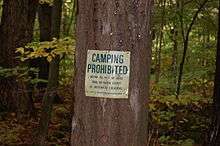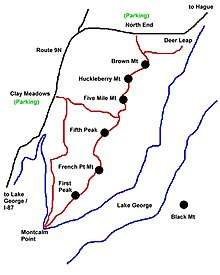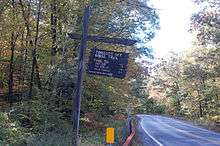Tongue Mountain Range Trails
The Tongue Mountain Range Trails are a series of hiking trails located within the Tongue Mountain Range, a subordinate range within the Adirondack Mountains of New York. The trails, 25 miles (40 km) in total length, vary from easy walks along the foot of the mountains on the shore of adjacent Lake George, to more rugged ascents of mountain peaks within the range.[1]
| Tongue Mountain Range Trails | |
|---|---|
 Five Mile Mountain summit | |
| Length | 25 mi (40 km) |
| Location | Warren County, New York, USA |
| Trailheads | Various |
| Use | Hiking |
| Elevation | |
| Elevation change | 1,258 ft (383 m) |
| Highest point | Five Mile Mountain, 2,258 ft (688 m) |
| Hiking details | |
| Trail difficulty | Easy to strenuous |
| Season | Easiest late May to mid-October |
| Hazards | Severe weather, timber rattlesnakes |
Trail description

The Tongue Mountain Range consists of six summits along the ridge, First Peak, French Point Peak, Fifth Peak, Five Mile Mountain (highest point in Town of Bolton), Huckleberry Mountain and Brown Mountain. The Five Mile Mountain trail takes in Five Mile Mountain, Huckleberry Mountain and Brown Mountain. There are lean-to’s for overnight camping at Fifth Peak and Brown Mountain. The path passes through wooded and open exposed rock areas. The elevation change on the trail is 1,258 feet (383 m). Other trails run from Clay Meadow to take in the southern half of the range, First Peak, French Point Peak and Fifth Peak.
Trail vistas take in the Adirondacks, Lake Champlain, and the Green Mountains of Vermont. Camping and fires are allowed along the Tongue Range Trails within areas designated by the New York Department of Environmental Conservation. Specific regulations are enforced and leave no trace guidelines encouraged.[2] Camping and fires are prohibited above an elevation of 4,000 feet (1,219 m).
Geology
The Tongue Mountain Range is composed of quartz-bearing syenite.[3] It runs 10 miles (16 km) south into Lake George at the southern end of the Narrows Group of lake islands. Tongue Mountain used to be part of the separation between two ancient rivers preceding the modern Lake George.
Ecosystem
The area is a protected wildlife preserve and boasts many species of trees, plants and animals. Dr Patrick L. Cooney of the New York Botany Organisation has listed fifteen species of trees, sixteen fern species, and over sixty species of herbs along the trails.[4] Exposed rocky outcrops along the rock faces are covered with mosses and lichens, and are considered to be fragile habitats. The area is also known for its population of timber rattlesnakes. These are large snakes some approaching 5 feet (1.5 m) in length.[5] They enjoy the shelter in the wooded areas but also enjoy basking in the sun on exposed rocks. Numerous birds inhabit or visit the area including various waterfowl and Peregrine Falcons.

The Tongue mountains were once a source of commercial timber. During the 19th century, approximately half the forest of the range fell to the logger's ax.[4] As late as 1860, 10,000 softwood logs a year were being floated north to the sawmills at Ticonderoga. Hardwoods from the range went to feed the iron forges on Lake Champlain.
Gallery
 Deer Leap trail split
Deer Leap trail split General view of a trail
General view of a trail View of the Green Mountains
View of the Green Mountains Lichens on Brown Mt
Lichens on Brown Mt North End trailhead
North End trailhead Five Mile Mt summit
Five Mile Mt summit Brown Mt summit
Brown Mt summit Huckleberry Mt summit
Huckleberry Mt summit Lean to on Brown Mt
Lean to on Brown Mt Clay Meadow trailhead
Clay Meadow trailhead
References
- "Favorite hikes". Backpacker Magazine. February 2005.
- New York DEC web site
- Lake George Association Archived 2007-02-09 at the Wayback Machine
- New York Botany Organisation
- Brockway, Rick (2006-04-21). "Some snakes around here can get you really rattled". Daily Star (Oneonta, NY).
External links
- Topo map of the area
- New York DEC web site
- Adirondack Mountain Club web site
- Wadsworth, Bruce (2004). Day Hikes for all seasons - an Adirondack sampler (4th ed.). Adirondack Mountain Club. ISBN 0-935272-83-6.
- McMartin, Barbara; Bennett Chuck; Robbins Edythe (2001). Discover the Eastern Adirondacks. Lake View Press NY. pp. 229 pages. ISBN 1-888374-09-8.